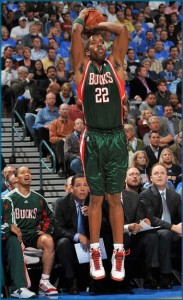Milwaukee Bucks shooting guard Michael Redd is the only player from the 2000 NBA Draft still playing in the colors that drafted him. Standing in his locker Monday night after the Bucks’ stat-padding 93-86 victory over the Toronto Raptors, Redd understood exactly why there was a media swarm around him interested in things other than his 15 minutes and 2 points on 1-6 shooting.
“I know the connection here is special between myself and the city, and the fans, it’s been an awesome 11 years,” Redd said. “You don’t see late second round picks stick with an organization this long. I’m very honored and overwhelmed with the respect from Senator Kohl and what I have for him.”
By Jake McCormick
It’s too easy to write a farewell piece wishing Michael Redd the best and reminiscing on his best moments as a member of the Milwaukee Bucks (most notably a franchise record 57 point performance against the Utah Jazz in 2006).
Rather, the end result of that chuck-happy effort five years ago reflects much more accurately on Redd as a person, his commitment to the Bucks, and the ripple effect of his decision to remain in Milwaukee through his prime.
The Associated Press’ introductory line from that November 11, 2006 tilt at the Bradley Center:
“The best night in Milwaukee Bucks franchise history was not enough for a win.”
Michael Redd dropped 25-30 points, but the Bucks still lost. That was a common theme throughout Redd’s 11 year tenure in Milwaukee.
Redd didn’t play in the NBA postseason until 2002-03, never tasted the fruits of the second round, and never topped more than 42 wins as the team’s go-to guy. It’s safe to say that Michael Redd was the best player on a string of bad Bucks teams, but a part of his legacy will always be his own version of The Decision.
In the 2004 offseason, Redd was faced with the choice of sticking with a Bucks team that featured Keith Van Horn and Desmond Mason as prominent pieces or playing in his home state with a budding superstar named LeBron James.
Redd opted to sign a six year, $91 million that would tie him to Milwaukee until this summer. That was more than what the Cavaliers were offering, but Redd and current center Andrew Bogut seem to be in the rare club of players that choose to start and finish their careers on the shores of Lake Michigan.
Just imagine how different things might have been in Cleveland and around the NBA landscape if Redd chose to play with the best player on the planet, or if he was traded there amid speculation a few years ago. Instead, he chose to put his faith in a small market team that allowed him the opportunity to lead. There’s definitely some misguided ego involved in that decision, as Redd was never able to put the team on his back through a full season.
The fact that he’s mentioned in the same breath as Kareem Abdul-Jabbar as the only two Bucks players to score more than 2,000 points in a season backs up the fact that Michael Redd was an unquestionably good player in Milwaukee. Factor in his draft spot (second round, 43rd overall) and his career looks even better.
Redd’s final 15 minutes in the Bradley Center culminated in a post-game standing ovation as the de facto face of the mid-to-late 2000s Milwaukee Bucks walked off the court for the last time. It was certainly bittersweet for a player coming off consecutive years of serious rehab, but adversity rarely yields an ending we expect.
Follow Jake on Twitter.
